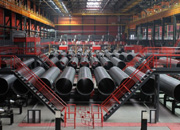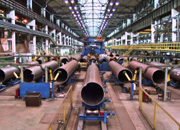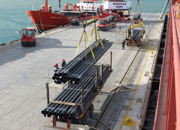Welding method of galvanized steel pipe
Update:2025-04-08 View(s):11 Keywords :galvanized steel pipe, galvanized steel pipe welding, galvanized steel pipe machining
Galvanized steel pipe has the dual advantages of corrosion resistance and long service life, and the price is relatively low, so its usage rate is getting higher and higher now. However, some users are not careful when welding galvanized pipes, which leads to some unnecessary troubles. So what problems should be paid attention to when welding galvanized pipes?
1. The premise is to grind
The galvanized layer at the welding point must be polished off, otherwise, bubbles, sand eyes, false welding, etc. will be generated. It will also make the weld brittle and reduce rigidity.
2. Characteristics of zinc-plated steel pipe
Galvanized steel is generally coated with a layer of zinc on the outside of low-carbon steel, and the galvanized layer is generally 20um thick. The melting point of zinc is 419°C and the boiling point is about 908°C. In welding, zinc melts into liquid and floats on the surface of the molten pool or at the root of the weld. Zinc has a large solid solubility in iron. The zinc liquid will deeply erode the weld metal along the grain boundary, and the low-melting-point zinc forms "liquid metal embrittlement". At the same time, zinc and iron can form intermetallic brittle compounds. These brittle phases reduce the plasticity of the weld metal and produce cracks under tensile stress. If the fillet weld is welded, especially the fillet weld of the T-joint, it is most likely to produce through cracks. When galvanized steel is welded, the zinc layer on the surface and edge of the groove will oxidize, melt, evaporate, and volatilize white smoke and steam under the action of arc heat, which can easily cause weld porosity. ZnO formed by oxidation has a high melting point of about 1800°C or above. If the parameters are too small during the welding process, ZnO slag inclusion will occur. At the same time, because Zn becomes a deoxidizer, FeO-MnO or FeO-MnO-SiO2 low melting point oxide slag inclusion will be produced. Secondly, due to the evaporation of zinc, a large amount of white smoke will be volatilized, which will irritate and harm the human body. Therefore, the galvanized layer at the welding point must be polished off.
3. Welding process control
The pre-welding preparation of galvanized steel is the same as that of general low-carbon steel. It is important to carefully handle the groove size and the nearby galvanized layer. In order to weld through, the groove size should be appropriate, generally 60~65°, and a certain gap should be left, generally 1.5~2.5mm; in order to reduce the penetration of zinc into the weld, the galvanized layer in the groove can be removed before welding. In actual work, the centralized groove is used, and the process of not leaving a blunt edge is used for centralized control. The two-layer welding process reduces the possibility of incomplete welding. The welding rod should be selected according to the base material of the galvanized steel pipe. Generally, J422 is more commonly used for low-carbon steel due to its easy operation.
4. Welding technique
When welding the first layer of the multi-layer weld, try to melt the zinc layer and make it vaporize and evaporate to escape the weld, which can greatly reduce the liquid zinc left in the weld. When welding fillet welds, try to melt the zinc layer in the first layer and make it vaporize and evaporate to escape from the weld. The method is to first move the end of the electrode forward about 5 to 7 mm, and then return to the original position and continue welding forward after the zinc layer is melted. When welding horizontally and vertically, if you use short slag electrodes such as J427, the edge-biting tendency will be very small; if you use the back-and-forth rod movement technology, you can get defect-free welding quality.
 Threeway Steel is known as a professional supplier engaged in manufacturing and distributing a wide range of steel pipe, and our headquarter located the central part of China – Hunan and six associated factories throughout China.
Threeway Steel is known as a professional supplier engaged in manufacturing and distributing a wide range of steel pipe, and our headquarter located the central part of China – Hunan and six associated factories throughout China.
 Threeway Steel is known as a professional supplier engaged in designing, manufacturing and distribution of a wide range of steel products with the headquarter located the central part of China – Hunan and six associated factories throughout China.
Threeway Steel is known as a professional supplier engaged in designing, manufacturing and distribution of a wide range of steel products with the headquarter located the central part of China – Hunan and six associated factories throughout China.
 Threeway Steel is known as a professional supplier engaged in designing, manufacturing and distribution of a wide range of steel products with the headquarter located the central part of China – Hunan and six associated factories throughout China.
Threeway Steel is known as a professional supplier engaged in designing, manufacturing and distribution of a wide range of steel products with the headquarter located the central part of China – Hunan and six associated factories throughout China.
 Threeway Steel is known as a professional supplier engaged in designing, manufacturing and distribution of a wide range of steel products with the headquarter located the central part of China – Hunan and six associated factories throughout China.
Threeway Steel is known as a professional supplier engaged in designing, manufacturing and distribution of a wide range of steel products with the headquarter located the central part of China – Hunan and six associated factories throughout China.
 Threeway Steel is known as a professional supplier engaged in designing, manufacturing and distribution of a wide range of steel products with the headquarter located the central part of China – Hunan and six associated factories throughout China.
Threeway Steel is known as a professional supplier engaged in designing, manufacturing and distribution of a wide range of steel products with the headquarter located the central part of China – Hunan and six associated factories throughout China.

